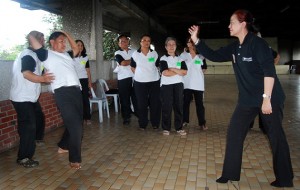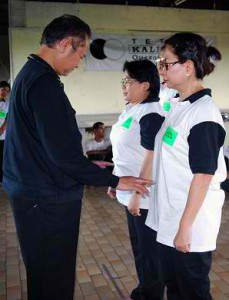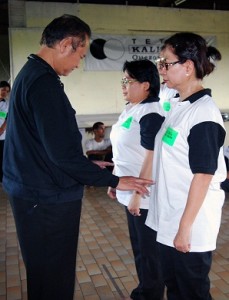IT was a good day for a physical and spiritual workout. A group of men and women wearing black-sleeved white T-shirts and black trousers silently performed what seemed to be a slow dance of coordinated arm and leg movements. Meanwhile, a man in dark pants and matching jacket scrutinized them, filming them as they moved in unison.
Occasionally he would pick out someone, stand before him and check his energy. This he did by putting his hand a few inches from the person’s body while probing the thickness and strength of the invisible layer of energy surrounding the individual.
After the energy-building exercises, the man moved his fingers to manipulate each student’s energy. With this slight movement, he “connected” them to their next learning level.
That man was H. Eddy Surohadi, Grandmaster of Tetada Indonesia, a martial art similar to pencak silat. Tetada draws its influences from different Asian martial arts traditions.
But while most martial arts are promoted as sport and self-defense, Tetada focuses on building good health and spiritual development as well as sharpening intuition. Tetada students also learn how to heal themselves and others.
“I learned from many styles,” says Pak Eddy, as he is fondly called by practitioners at the Vanguard building in the University of the Philippines-Diliman. “But Tetada is a new breathing method I made for wellness.”
In Tetada triangular breathing, a practitioner inhales, holds his breath for several seconds while focusing on the lower abdominal area, and then exhales. This method massages the stomach area, strengthens chest cavity and waist muscles as well as boosts the flow of energy to the entire body.
The breathing is supported by jurus, a set of nine martial art movements executed ideally while the mind is in meditative state, also known as the alpha level of awareness.
The jurus look like a repetitive but graceful dance. They are done to stimulate the chakras or energy centers located in different parts of the body. This is supposed to strengthen the physical body.
Guided meditation makes up the last part of Tetada. Practitioners learn to still the mind and ask for divine healing.
Occasionally, tests are conducted to check a student’s energy level and skills. These tests include dropping or stepping on a light bulb without breaking it and lifting a person on a newspaper without tearing the paper apart.
The more advanced students engage in adu panchar or energy sparring. In this exercise, energy is projected to a point below the navel. To the uninitiated, it looks as if practitioners are hurling invisible things at each other from a distance while being pushed by some unseen force.
In Indonesia, many military and police officers and personnel have learned Tetada techniques and are applying them at work, Pak Eddy said. “The police use it to find thieves,” he quipped, adding that with their sixth sense enhanced by regular practice, the police instinctively know in which direction a thief flees.
 Tetada techniques could also be used for self-defense. Pak Eddy recounted how one student was talking on the phone with his boss who was stuck in traffic. The boss rolled down his window and a thief immediately tried to grab his phone. The boss urgently asked the practitioner for help. The latter told his boss to make the phone face the hand of the thief. From his end, the practitioner did a jurus movement and the thief fell to the ground.
Tetada techniques could also be used for self-defense. Pak Eddy recounted how one student was talking on the phone with his boss who was stuck in traffic. The boss rolled down his window and a thief immediately tried to grab his phone. The boss urgently asked the practitioner for help. The latter told his boss to make the phone face the hand of the thief. From his end, the practitioner did a jurus movement and the thief fell to the ground.
Tetada techniques, however, won’t work if used to harm innocent people.
The term tetada comes from Terapy Tenaga Dalam or Inner Energy Cultivation. The art has existed for 500 years but was practiced only by the Javanese royal family. The power it brought to practitioners remained the clan’s closely guarded secret until December 1991 when Pak Eddy formally introduced it to the Indonesian public.
Pak Eddy learned martial arts at age 12 from his grandfather and his father, a silat warrior. Now, Tetada has become a way of life for him and his family.
“My blood pressure is very good and I thank God that everything is normal. My grandfather and mother suffered from high blood pressure. My father had high sugar levels. High blood, high blood sugar and asthma are genetic in my family,” Pak Eddy explained. “I exercise everyday because I am afraid of getting sick.”
Daily exercise for this soft-spoken and unassuming 59-year-old mining businessman from Surabaya, Indonesia means doing Tetada at 4:30-5:30am with his wife Ida, a medical dermatologist, and their 3 children.
Surabaya is Indonesia’s second largest city and the capital of East Java province.
Pak Eddy comes to the Philippines three times a year to “connect” and share his knowledge with practitioners here. His next trip to the Philippines will be in September.
His wife, whom practitioners fondly call Ibu Ida, is also a Tetada master and accompanies him during these trips. Pak and Ibu are Javanese honorifics. Pak means Sir, Mister or literally “Father” while Ibu means Madam, Ma’am, or literally “Mother”.
There are some 500 practitioners in the country with Tetada centers in Makati, Rizal, Cebu, Cagayan de Oro and Davao. At the UP Vanguard Center, Tetada students practice every Tuesday and Thursday evening and Saturday morning.
An estimated one million people worldwide now practice the art of Tetada. It has gained following in Austria, Brunei, Canada, Finland, France, Germany, Hong Kong, the Netherlands, and the United States.

